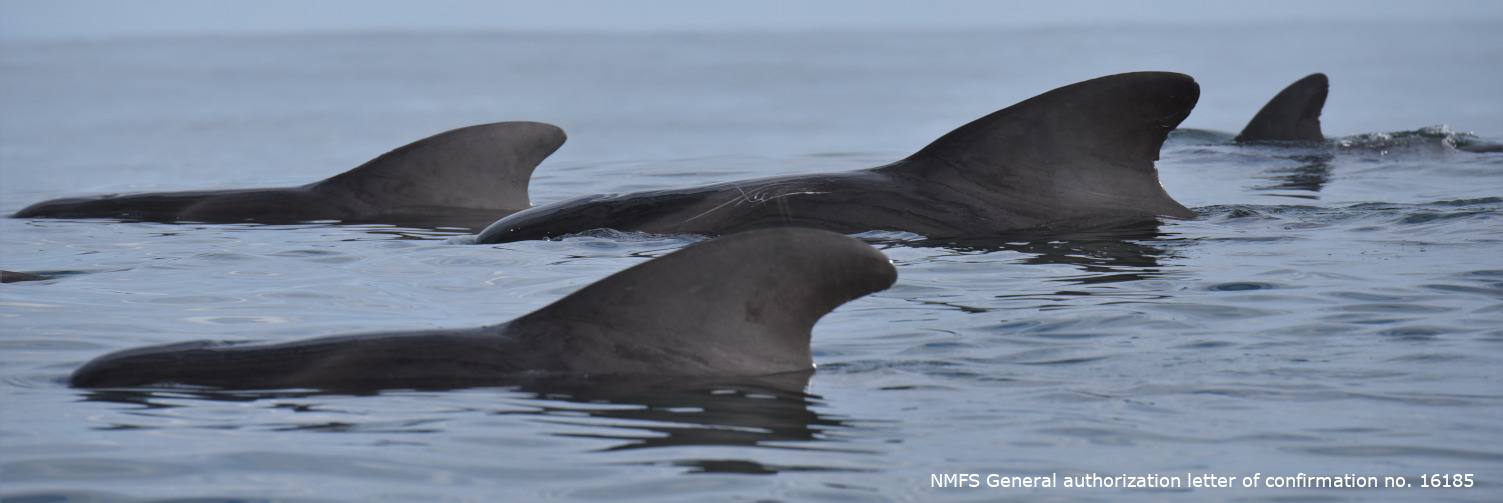
Project overview
This project involves field controlled exposure experiments (CEEs) to quantify the behavioral response of Cuvier’s beaked whales and short-finned pilot whales to tactical mid-frequency (3-4 kHz) active sonar (MFAS) off Cape Hatteras, North Carolina. The objective is to provide direct empirical measurements of behavioral response in relation to key exposure variables, including received exposure level, proximity to the source, and behavioral state. A multi-scale approach is applied, with simultaneous deployment of high-resolution, short-duration, archival acoustic and movement tags and lower-resolution, longer-term, satellite-linked depth-recording tags. Unlike many previous studies, this study is not being conducted on a training range, where animals are exposed to frequent bouts of intense sonar activity, but, instead, an area where MFAS is used infrequently, so that animals may be familiar with, but not habituated to sonar.
In addition to conducting and analzying these experiments, we have been working with colleagues on a number of other aspects which support the project. See below for details on the exposure experiments, but also some of our efforts to characterize the baseline behavior of these species in our study area, to develop new methods for measuring relevant behavior, and to visualize our data in engaging and useful ways.
Partners
Our partners on this project include: Southall Environmental Associates, Inc., Duke University Marine Laboratory, Sea Mammal Research Unit, Calvin College, Bridger Consulting, and the Naval Postgraduate school.
This project is funded by U.S. Fleet Forces Command and managed by Naval Facilities Engineering Command Atlantic as part of the U.S. Navy’s marine species monitoring program.
Baseline behavior
In order to understand if animals have modified their behavior, we have to be able to quanitfy the baseline variation in behavior, not just immediately prior to an experimental exposure, but also over longer time periods which provides information about the total range of behaviors in their repetoire and the rate at which they normally exhibit these behaviors. To this end we have been able to leverage a large amount of data already collected in our study site on both species prior to the BRS as well as data collected during the BRS but not during an experimental period.
- Foley et al. (In press) describes the residency and movement patterns of Cuvier’s beaked whales off Cape Hatteras. Stayed tuned for an update when it becomes available!
- Quick et al. 2020 used satellite tag dive data to try to estimate the aerobic dive limit of Cuvier’s beaked whales. Knowing the physiological capabilities of the species can help assess the impact of disturbance.
- Shearer et al. 2019 investigated the baseline diving behavior of Cuvier’s beaked whales in our study site and compared to previously published results from the west coast of the US. The deep long dives which we presume are primarily for foraging had a median depth of more than 1400 meters and a a median duration of more than 58 minutes!
Methods development
The Atlantic BRS utilizes a variety of data collection methods and technologies including photo-identification, focal follows, satellite-linked ARGOS tags, Digital Acoustic Recording Tags (DTAGS), and advanced modeling to predict exposure levels. Some of these methods have had to be applied in new ways to fit the needs of our experiments and we have worked closely with statisticians, engineers, and other experts to build upon the existing solutions.
- Hewitt et al. 2021 implemented a continuous-time discrete-space model for sparse time-series depth data collected using satellite-linked tags deployed during the Atlantic BRS.
- Quick et al. 2019 outlines our attempt to optimize our deployment of satellite tags for an experimental settings. These tags can be quite bandwidth limited, but data gaps can be devastating to a controlled experiment that relies on time-series information and so new strategies for leveraging the programming of existing bio-logging technologies were needed.
- Schick et al. 2019 details modeling approaches for characterizing received levels of sonar exposures while accounting for local sound propagation and positional uncertainty in satellite tags.
Visualizations
A talented group of undergraduate students at Duke University working with Rob Schick have been developing data packages and dashboard data visualizations to help us explore and summarize our data. These types of tools are useful for analysts, but also can help us share our data with colleagues, other researchers, and the public. See links below to try out two web applications the students developed:
- The 2019 dashboard shows an overview of the 2019 data.
- The 2019 CEE Shiny App shows a more in depth look at some of the data generated around experimental exposures.
Response analyses
During the first three years of this project, we have tagged 46 Cuvier’s beaked whales and 49 short-finned pilot whales and conducted 14 controlled exposure experiments (CEEs), each with multiple tagged individuals of both species, including three trials with full-scale tactical MFAS systems from Navy ships, nine trials with a high-power simulated MFAS, and two no-sonar controls. Modeled and measured received levels range up to 140 and 150 dB re 1 uPa for beaked and pilot whales, respectively. We noted behavioral response in some, but not all, individuals, including short-term changes in diving behavior and in some cases strong and obvious horizontal avoidance. We did not observe any large-scale abandonment of habitat in either species, and behavioral responses were generally ephemeral, with animals resuming typical diving behavior within hours of exposure to MFAS transmissions.
- We have recently completed our 2020 field season and are in the midst of planning our 2021 field season.
- Keep posted for updates. Feel free to check news and links for field updates and our annual reports are posted in publications